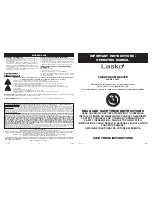
1. Safety valve supplied with the water heater.
2. Safety unit lever.
3. Drain pipe.
4. Safety valve.
5. Pressure Reducer Valve (PRV): never install near to
the heater when pressure is above 5 kg/cm
2
.
6. Insulating bushings supplied with the heater.
Figure 1
Figure 2
3.1.- HYDRAULIC INSTALLATION
WARNING TO THE INSTALLER: The insulating
bushings, supplied with the immersion heater, must be
fitted to the inflow and outlet pipes, and Teflon tape on
pipe threads used to eliminate risks of galvanic
couplings. Bushing tightening torque: 3.5 kgm.
Before carrying out hydraulic connection, the supply
pipes must be cleaned to ensure that no foreign or
metallic particles enter the water heater.
Install the water heater according to the diagram:
a) The water heater MUST be installed with the safety
unit, fitted with the check valve (supplied by the water
heater).
No hydraulic accessory must be fitted between the safety unit and the cold water pipe to the heater
inlet (shut-off valve, check valve, etc.).
The discharge outlet of the safety unit MUST be connected to a drain pipe, which is at least equal in
diameter to that of the immersion heater connection pipe, with a continuous slope and open to the
atmosphere, ensuring there is a minimum distance of 20 mm as indicated in Figure 1. This pipe must
be installed where is no possible risk of frost and sloping downwards.
During the heating period, the water expands causing dripping
(approximately 3% of its capacity for each heating cycle). Do not worry as
that is normal.
In order to drain the immersion heater, you need to trigger the safety
unity by lifting the lever, as indicated in Figure 2.
The lever should be triggered from time to time to stop it blocking and
check it is working correctly.
b) When the supply network pressure exceeds 5 bars, you MUST fit a Pressure Reducer Valve (PRV) to
the house water supply system. A pressure of 3 to 4 bars is recommended.
c) If plastic pipes are used for the installation, the temperature and pressure to which they are going to
be subject must be taken into account. There should be a maximum pressure of 9 bars and maximum
temperature of 70 ºC under normal conditions or 100 ºC under abnormal outage conditions of the
safety thermostat.


































